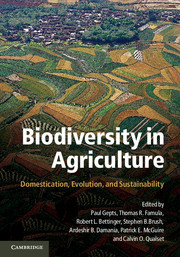Book contents
- Frontmatter
- Contents
- Tables
- Figures
- Foreword
- Contributors
- Acknowledgments
- Introduction: The Domestication of Plants and Animals: Ten Unanswered Questions
- 1 The Local Origins of Domestication
- Section I Early Steps in Agricultural Domestication
- Section II Domestication of Animals and Impacts on Humans
- Section III Issues in Plant Domestication
- Section IV Traditional Management of Biodiversity
- Section V Uses of Biodiversity and New and Future Domestications
- Index
Section IV - Traditional Management of Biodiversity
Published online by Cambridge University Press: 05 June 2012
- Frontmatter
- Contents
- Tables
- Figures
- Foreword
- Contributors
- Acknowledgments
- Introduction: The Domestication of Plants and Animals: Ten Unanswered Questions
- 1 The Local Origins of Domestication
- Section I Early Steps in Agricultural Domestication
- Section II Domestication of Animals and Impacts on Humans
- Section III Issues in Plant Domestication
- Section IV Traditional Management of Biodiversity
- Section V Uses of Biodiversity and New and Future Domestications
- Index
Summary
Traditional Management of Biodiversity
The contributions to this section deal with the connection between biological diversity in agriculture and its social, cultural, and geographic contexts. Crop evolution is generally understood through the processes of domestication that generated cultivated species and allowed the transformation of human life ways. Domestication set the stage for the transformation of subsistence and human social systems. The success of this transformation required not only new species of plants and animals but also a suite of allied technologies, organizational innovations, and behavioral change. The establishment of agricultural systems involving technology, social and economic organization, and cultural patterns was no less an accomplishment than crop domestication in the transformations that emerged at the end of the Pleistocene.
While the origins of agriculture through the processes of domestication and organization of food production systems loom very large in the evolution of crops and human society, both crops and agricultural systems have continued to evolve, and this evolution is significant to such concerns as the conservation of biological diversity and to meeting future needs such as those posed by climate change. Crop evolution after domestication is marked by such things as diffusion and adaptation to new habitats and the diversification of cultivars. The evolution of agricultural systems is marked by the elaboration of human knowledge systems about cultivated plants, change in social organization such as the elaboration of hierarchy, and dynamic economic organization for the allocation of resources and the distribution of production.
- Type
- Chapter
- Information
- Biodiversity in AgricultureDomestication, Evolution, and Sustainability, pp. 375 - 376Publisher: Cambridge University PressPrint publication year: 2012



